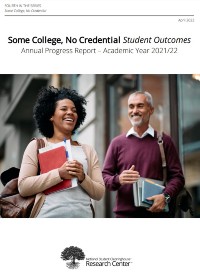Report Finds More U.S. Students Leaving Higher Ed Without a Credential
The decision to stop attending college or university without earning a credential is a big one, and college dropouts are faced with another sizable choice once they leave — whether to return. The population of ‘some college, no credential,’ or SCNC, individuals in the United States has reached 40.4 million (out of a total U.S. population of 331 million), which has resulted in a nationwide push for former students to return to college.
To provide a statistical base for these efforts to spur re-enrollment, the National Student Clearinghouse Research Center released its fourth annual progress report in the series “Some College, No Credential Student Outcomes.” The report, which covers the 2021-22 academic year, includes data from 97 percent of all college degree-granting institutions and provides details about the academic trajectories of SCNC individuals and opportunities to re-engage with former students.
“To succeed in bringing them back into higher education, state and institutional leaders need accurate and timely information about the current SCNC population, their progress, and outcomes upon re-enrollment, which is the focus of this annual progress reporting of SCNC students,” the report reads. “This year’s report suggests that there is an increasingly missed opportunity for states and institutions to re-engage with SCNC students even as the SCNC population is growing.”
Metrics used in the report include re-enrollment, first-credential and perseverance:
- Re-enrollment describes SCNC students who stopped college for a minimum of three consecutive terms but are now enrolled during this academic year, and a total of 864,800 students re-enrolled this academic year.
- First-credential describes students getting their first undergraduate degree or certificate after going back to college in their first or second year, and during this academic year, 53,300 returning students earned a credential.
- Perseverance explains students continuing college after re-enrolling last academic year, and 508,700 of the students who re-enrolled last year continued from 2021 to 2022.
During the 2021 to 2022 academic year, the population of SCNC students increased by 1.4 million from the 39 million in 2020. Fewer SCNC students re-enrolled, persevered, or earned a degree or certificate. According to the report, more than 94 percent of the SCNC students from last year did not return, and the increase in students who left college can be attributed to the 2.3 million new stop-outs and a lack of re-enrollment.
All 50 states and the District of Columbia saw a growth in SCNC populations this academic year, and 45 states have set a “postsecondary attainment goal,” or efforts to boost education levels. (See the state-by-state specifics here.)
The report notes that among college dropouts, potential completers (which are students who completed two or more years of school during the last 10 years), and recent stop-outs (new dropouts as of May 2022), will be important demographics to target for re-enrollment efforts. The two groups of SCNC students are the most likely to go back to college and complete a credential once they go back. In fact, 6.1 percent of potential completers and 9.4 percent of recent stop-outs re-enrolled in college this academic year. Nonetheless, it is important to understand key demographic identifiers of students that are likely to re-enroll so state and institution leaders understand their target audience.
Most SCNC students went to school in California. However, Alaska has the largest percentage of SCNC students in the U.S. relative to their state enrollment. The report found 58.3 percent of students who left college before completing a degree attended a community college, and most students attend a community college upon re-enrollment as well. Dropouts also tend to be primarily female, and students who identified as Asian had the highest success and progress rate, and Black students the lowest.
SCNC students also tend to be younger than 35 when they last attended school, and 44 percent of former students were under 25 when they dropped out of college. Potential completers and recent stop-outs tend to be even younger than their other SCNC counterparts. In fact, 55.6 percent of potential completers are in their early 20s and 24.6 percent of recent stop-outs are younger than 20.


























































































